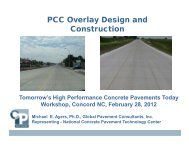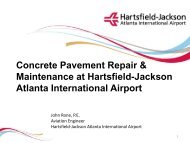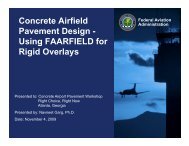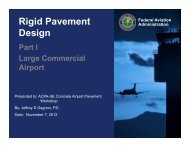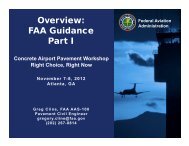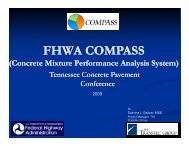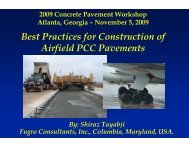NCDOT Experience with Diamond Grinding - American Concrete ...
NCDOT Experience with Diamond Grinding - American Concrete ...
NCDOT Experience with Diamond Grinding - American Concrete ...
- No tags were found...
Create successful ePaper yourself
Turn your PDF publications into a flip-book with our unique Google optimized e-Paper software.
<strong>NCDOT</strong> <strong>Experience</strong> <strong>with</strong><br />
<strong>Diamond</strong> <strong>Grinding</strong><br />
John Depman<br />
International Grooving and<br />
<strong>Grinding</strong> Association
Learning Objectives<br />
◦ Introduction to <strong>Diamond</strong> <strong>Grinding</strong><br />
◦ Advantages, Benefits and Use<br />
◦ Performance and Costs<br />
◦ <strong>NCDOT</strong> Projects<br />
◦ Summary
What is <strong>Diamond</strong> <strong>Grinding</strong><br />
◦ Removal of thin surface layer of hardened<br />
PCC using closely spaced diamond saw<br />
blades;<br />
◦ Results in smooth, level l pavement surface;<br />
◦ Longitudinal texture <strong>with</strong> desirable friction<br />
and low noise characteristics;<br />
◦ Frequently performed in conjunction <strong>with</strong><br />
other CPR techniques, such as full-depth<br />
repair, dowel bar retrofit, and joint resealing.<br />
◦ Comprehensive part of any PCC Pavement<br />
Preservation program;
<strong>Diamond</strong> <strong>Grinding</strong><br />
<strong>Diamond</strong> <strong>Grinding</strong><br />
Cutting Head
<strong>Diamond</strong> <strong>Grinding</strong><br />
Dimensions<br />
<strong>Diamond</strong> <strong>Grinding</strong><br />
Width of diamond blades<br />
(.10 to .125 inches)<br />
Land area - .080 inches for hard aggregate<br />
- .110 inches for soft aggregate<br />
<strong>Grinding</strong>
<strong>Diamond</strong> <strong>Grinding</strong><br />
<strong>Diamond</strong> <strong>Grinding</strong><br />
<strong>Grinding</strong> Machine
<strong>Diamond</strong> <strong>Grinding</strong><br />
<strong>Diamond</strong> <strong>Grinding</strong><br />
<strong>Grinding</strong> Process
<strong>Diamond</strong> <strong>Grinding</strong><br />
<strong>Diamond</strong> <strong>Grinding</strong><br />
Finished Product
<strong>Diamond</strong> <strong>Grinding</strong> Was<br />
Invented in California<br />
◦ <strong>Diamond</strong> grinding was first used in California<br />
in 1965 on a 19-year old section of I-10 to<br />
eliminate significant faulting (Neal and<br />
Woodstrom 1976).<br />
◦ In 1983, CPR was conducted on this same<br />
pavement section, including the use of<br />
additional grinding to restore the rideability<br />
and skid resistance of the surface. In 1997,<br />
the process was repeated.<br />
◦ Since its first use in 1965, the use of diamond<br />
grinding has grown to become a major<br />
element of PCC pavement preservation.
Effectiveness of <strong>Diamond</strong> <strong>Grinding</strong> -<br />
CALTRANS<br />
◦ CALTRANS has determined<br />
that the average life of a<br />
diamond ground<br />
pavement surface is 17<br />
years and that a pavement<br />
can be ground at least<br />
three times <strong>with</strong>out<br />
t<br />
affecting pavement<br />
structurally. See IGGA.net<br />
for full report<br />
STATE OF CALIFORNIA<br />
DEPARTMENT of TRANSPORTATION<br />
DIVISION OF<br />
ENGINEERING SERVICES<br />
MATERIALS ENGINEERING<br />
AND TESTING SERVICES<br />
OFFICE OF RIGID PAVEMENT<br />
AND STRUCTURAL CONCRETE<br />
5900 Folsom Boulevard<br />
Sacramento, California 95819<br />
THE EFFECTIVENESS OF DIAMOND GRINDING<br />
CONCRETE PAVEMENTS IN CALIFORNIA<br />
November 2004
Advantages of <strong>Diamond</strong> <strong>Grinding</strong><br />
◦ Costs substantially ti less than AC overlays;<br />
◦ Enhances surface friction and safety;<br />
◦ Can be accomplished during off-peak hours <strong>with</strong><br />
short lane closures and <strong>with</strong>out encroaching into<br />
adjacent lanes;<br />
◦ <strong>Grinding</strong> of one lane does not require grinding of<br />
the adjacent lane;<br />
◦ Does not affect overhead clearances underneath<br />
bridges;<br />
◦ Blends patching and other surface irregularities<br />
into a consistent, identical surface;<br />
◦ Environmentally friendly.
Pavement Problems Addressed<br />
◦ Faulting at joints and cracks<br />
◦ Built-in or construction roughness<br />
◦ Polished concrete surface<br />
◦ Wheelpath rutting<br />
◦ Permanent upward slab warping<br />
◦ Inadequate transverse slope<br />
◦ Unacceptable noise level
Faulted Joints
<strong>Diamond</strong> grinding can provide a 60% to 70%<br />
<strong>Diamond</strong> grinding can provide a 60% to 70%<br />
improvement over the pre-grind profile on average!
Safety
Polished Surface
Safety, Surface Texture and Friction<br />
◦ Increased macrotexture of diamond ground<br />
pavement surface provides for improved<br />
drainage of water at tire-pavement interface<br />
◦ Longitudinal texture provides directional<br />
stability and reduces hydroplaning (side-force<br />
friction) Grooves provide “escape route” for<br />
water trapped between tire and pavement<br />
surface<br />
◦ In Wisconsin, overall accident rates for<br />
ground surfaces were 40% less than for un-<br />
ground surfaces over a 6-year period, 57% in<br />
wet weather conditions(Drakopoulos et al.<br />
1998)
Safety<br />
◦ Increased macrotexture of diamond d ground<br />
pavement surface provides for improved<br />
drainage of water at tire-pavement interface<br />
◦ Grooves provide “escape route” for water<br />
trapped between tire and pavement surface<br />
◦ Reduces the potential for hydroplaning
Wheel Path Rutting
Curling
Unacceptable Noise Level
Traffic Control
Traffic Management<br />
◦ Minimal traffic control required<br />
◦ Perform off-peak hours<br />
◦ Short closures - re-open lanes as needed<br />
◦ No equipment encroachment into other<br />
lanes<br />
◦ Can do just one lane<br />
◦ Does not affect overhead clearances
Performance
<strong>Diamond</strong> <strong>Grinding</strong> Study<br />
By ERES<br />
6<br />
(12)<br />
2<br />
1<br />
(4)<br />
2 6<br />
(10)<br />
(1)<br />
(7)<br />
1<br />
4<br />
2<br />
(11)<br />
(5)<br />
(10)<br />
1<br />
(6)<br />
(2) 5<br />
(10)<br />
1<br />
(3)<br />
1 1<br />
(2)<br />
(2)<br />
5 6 (4)<br />
3 4<br />
(27)<br />
(1)<br />
6<br />
(4)
AASHTO Design Model<br />
Prediction vs. Actual Traffic<br />
Tra affic, milli ion ESAL Ls<br />
60 AASHTO design model prediction i (50% reliability)<br />
Cumulative traffic (construction to grinding)<br />
50<br />
40<br />
30<br />
20<br />
10<br />
Total traffic since initial construction<br />
0<br />
FL I-10 AL I-20 NC I-26 SC I-85 GA I-75 GA I-85
<strong>Diamond</strong> <strong>Grinding</strong> Study<br />
By ERES<br />
◦ Extends service life;<br />
◦ Initial smoothness comparable to<br />
new pavement or overlay;<br />
◦ Average life of 32 years;<br />
◦ May be reground 3 to 4 times;
Effectiveness of <strong>Diamond</strong> <strong>Grinding</strong> -<br />
CALTRANS<br />
◦ CALTRANS has determined<br />
that the average life of a<br />
diamond ground<br />
pavement surface is 17<br />
years and that a pavement<br />
can be ground at least<br />
three times <strong>with</strong>out<br />
t<br />
affecting pavement<br />
structurally. See IGGA.net<br />
for full report<br />
STATE OF CALIFORNIA<br />
DEPARTMENT of TRANSPORTATION<br />
DIVISION OF<br />
ENGINEERING SERVICES<br />
MATERIALS ENGINEERING<br />
AND TESTING SERVICES<br />
OFFICE OF RIGID PAVEMENT<br />
AND STRUCTURAL CONCRETE<br />
5900 Folsom Boulevard<br />
Sacramento, California 95819<br />
THE EFFECTIVENESS OF DIAMOND GRINDING<br />
CONCRETE PAVEMENTS IN CALIFORNIA<br />
November 2004
Noise Performance<br />
◦ So what is all<br />
this noise<br />
about<br />
diamond<br />
grinding in<br />
Arizona!
Typical ARFC Noise Research<br />
Results -ADOT<br />
CPX Noise Levels dBA<br />
AR_ACFC Noise Levels Versus Pavement Age<br />
102<br />
101<br />
100<br />
y = 0.5453x + 93.279<br />
R 2 = 0.5805<br />
99<br />
98<br />
97<br />
96<br />
95<br />
94<br />
93<br />
0 2 4 6 8 10 12 14<br />
Pavement Age<br />
◦ “The results shown<br />
represent the average of<br />
twenty projects. The<br />
projects were located on I-<br />
8, and I-10, and ranged in<br />
age from three years to<br />
twelve years. The<br />
regression indicates<br />
approximately a 5 dBA<br />
increase in noise generation<br />
in a ten year period. The<br />
current data further<br />
indicates that AR-ACFCs<br />
typically range from 94 to<br />
99 dBA throughout their<br />
life.”
California and Arizona PCCP SI<br />
Test Results
<strong>Diamond</strong> <strong>Grinding</strong> -The Long Life<br />
Solution to Tire/Pavement Noise
Costs<br />
◦ Depends on —<br />
• Aggregate and PCC mix properties;<br />
• Average depth of removal;<br />
• Smoothness specifications;<br />
• Size of the project;<br />
• Work schedule;<br />
Cost effective whether used alone or as part of a<br />
comprehensive CPR program. In most cases, the<br />
cost of diamond grinding is only about half the cost<br />
of bituminous overlay.
Costs<br />
◦ Soft limestone — as low as $1.50 per sq. yd.<br />
◦ Hard river gravel — as high as $10.00 per<br />
sq. yd.<br />
◦ Typical price — $2.00 to $4.00 per sq. yd.<br />
*for a job <strong>with</strong> min. 20,000 sq. yds. and reasonable traffic<br />
control requirements
Evaluate Rideability<br />
◦ Rainhart profilograph (or similar)<br />
◦ Take traces before and after<br />
grinding<br />
◦ Should be able to provide 60% to<br />
70% improvement over pre-grind<br />
profile<br />
◦ Verify profile index against<br />
specification requirement
<strong>NCDOT</strong> Projects – Reasons for DG<br />
A) I-85 in Salisbury (Ride quality)<br />
B) I-95 North of Henderson (Rehab)<br />
C) I-40 in Orange/Durham Counties (Rehab)<br />
D) I-77 in Yadkin Co. (DB as benefit to<br />
<strong>NCDOT</strong>)<br />
E) I-26 in Hendersonville (Rehab)<br />
F) US1 in Cary (Included in Contract due to work)<br />
G) NC 147 in Durham (Rehab)<br />
H) WWF (NCTA Project) (Noise Reduction)
I-40 in Orange/Durham Counties<br />
DG as part of PCCP rehabilitation<br />
Completed in 2011
NC 147 in Durham ($2.60/SY)<br />
DG as part of PCCP rehabilitation<br />
Completion in early 2012
NCTA: WWF project in Wake County<br />
DG entire project for noise reduction<br />
Completion date December 2012
<strong>NCDOT</strong> DG Projects – IRI Results<br />
Location IRI (avg) – IRI (avg) –<br />
Before DG<br />
After DG<br />
I-85 102.4 55.0<br />
I-95 116.2 46.5<br />
I-40 (2010) 102.7 61.9<br />
I-77 (DB – 2009) 112.6 61.0<br />
I-26 99.3 (Faulting) 75.4<br />
US 1 (2006) 94.9 60.8<br />
NC 147 (2012) 121.4 57.0<br />
WWF (2013) 38.9
It’s a Fact!<br />
◦ <strong>Diamond</strong> grinding can provide<br />
the safest, smoothest, most<br />
quiet PCC pavement texture<br />
available when properly<br />
designed and constructed <strong>with</strong><br />
durable aggregates!
FHWA Technical Advisory<br />
◦ TA 5040.36 Surface Texture For<br />
Asphalt And <strong>Concrete</strong> Pavements<br />
- State Of Practice Surface Texture<br />
includes diamond ground surfaces<br />
for new pavements<br />
- Technique Recommended<br />
Application<br />
- Factors For Selecting Texture<br />
Techniques<br />
◦ See IGGA.Net for a copy of TA<br />
5040.36
Summary<br />
◦ <strong>Diamond</strong> grinding can extend pavement life<br />
significantly at a competitive cost.<br />
◦ <strong>Diamond</strong> grinding is a key Preventive Maintenance<br />
tool.<br />
◦ <strong>Diamond</strong> grinding will increase customer<br />
satisfaction, increase friction, reduce noise and<br />
reduce life cycle costs.<br />
◦ Performance and cost vary <strong>with</strong> given conditions.<br />
◦ Timing i is everything.<br />
◦ ACPA and IGGA are ready to assist!



